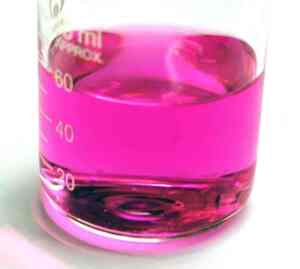Activity 2.6 NCERT Class 10 Science, Chapter 2 Acids, Bases, and Salts.
Procedure:
This activity asks us to add a few drops of phenolphthalein into dilute sodium hydroxide and see what happens when we add dilute acid.
Observation: Adding phenolpthalein into dilute sodium hydroxide turns the solution pink. Now, when we add dilute acid in it, a time comes when solution become colurless again.
Explanation:

Phenolphthalein is a colourless reagent. It gives the pink to the solution at basic PH while at acidic PH the solution remain colour less. So, It is used in an acid-base titration to see the endpoint. In the above experiment ist solution is basic so we see pink colour. Subsequent addition of dilue acid neturalises the solution and at the end makes the solution acidic. As a result, the pink colour disappears.
Note:If we add dilute base after adding acid then situation will reverse and the solution gets own previous pink colour.
Basic solution + phenolpthalein ⇒ Pink colour
Acidic solution + phenolpthalein ⇒ Colourless
Inference/conclusion: A change in colour of PH indicator can indicate the completion of a reaction.
Next: Metal oxides react with acids to form its salt, Activity 2.7.
Read also: Metal carbonate reacts with acids to form carbon dioxide, Activity 2.5.
See the discussion on some other PH Indicators at Activity1.1.
Very nice and good explanation . I really enjoyed it reading
Hume to ekhi bar me samajh me ajata hei kyun ki teacher hi achi hei.but you’re also right
this is very helpful read carefully and enjoy it
it very helpful for me i am class10
It is helpful if u read it twice thank youu 🙂
very useful
It was not that much helpful needs a nice explanation….
Thanks so much sir.It helped me a lot.
Pls. Write a conclusion for activity 2.6
Very useful , before reading this it was hard to understand. But now after going through these pages ,it made me understood these activities very clear to me.
Thank you studdy.